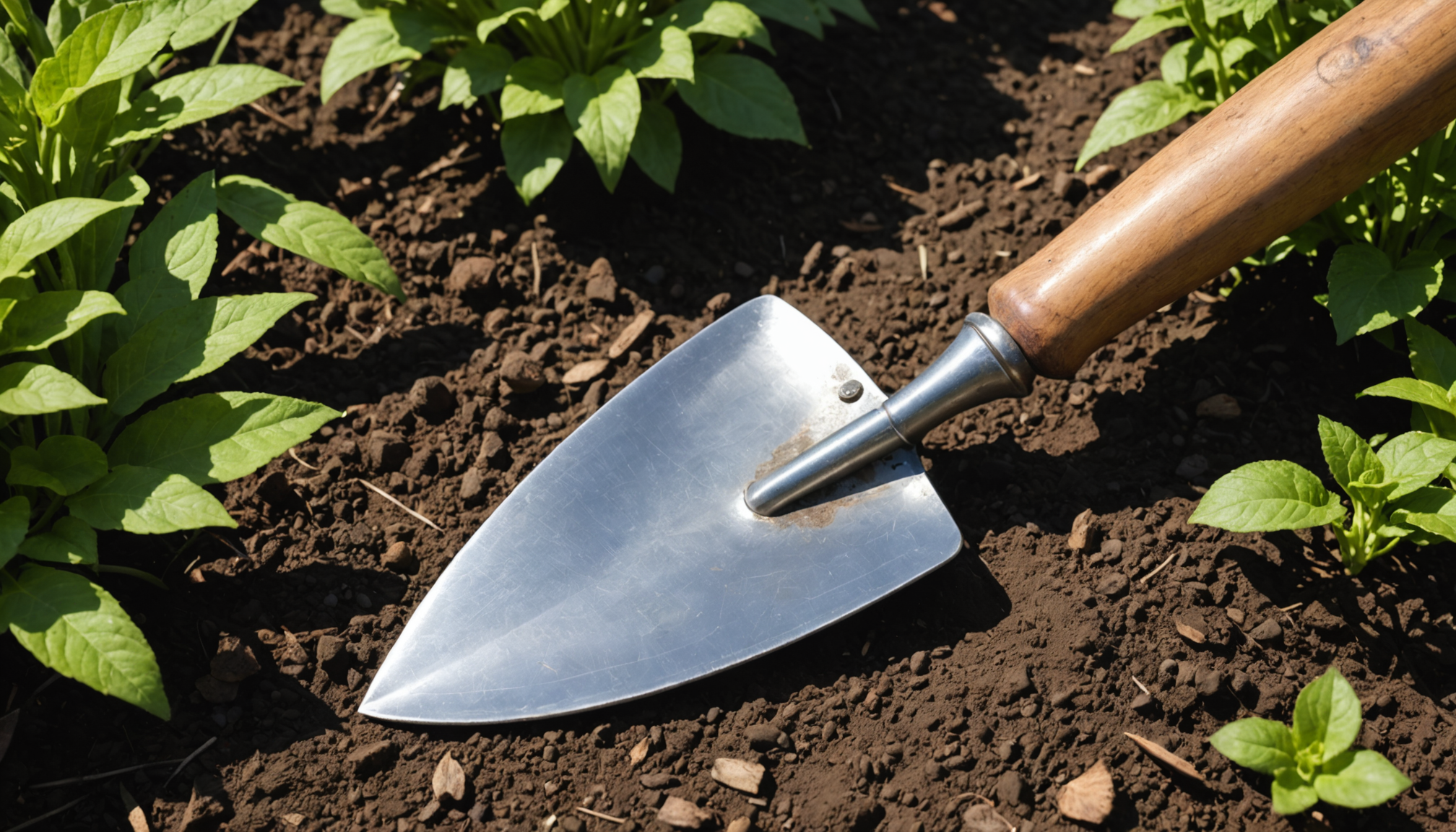Embarking on a journey into the world of gardening can be both rewarding and therapeutic. For beginner gardening enthusiasts, understanding which essential hand tools to invest in is critical for developing a thriving garden. Hand tools are the cornerstone of any gardener’s collection; they are versatile, reliable, and easy to use, providing the foundational support needed to tackle various gardening tasks.
When assembling your collection of gardening tools, it is vital to know which hand tools are indispensable. At the top of the list is the hand trowel. This small yet robust tool is vital for digging holes, planting seedlings, and removing weeds. Its compact size allows for precision work in confined spaces, making it perfect for container gardening or small beds.
The garden fork, often underestimated, plays a critical role in turning and aerating the soil. This tool is a must-have for those who wish to improve soil health and promote better plant growth. The garden fork’s sturdy tines penetrate compact earth, aerate the soil, and help incorporate essential nutrients, providing your plants a healthier growing environment.
Next is the hand pruners, an essential component for maintaining plant health. Regular pruning encourages plant vigour and productivity by removing dead or diseased branches. Pruners should be sharp and comfortable in the hand, allowing for precise cuts without damaging the plant.
Another vital tool is the weeder. Hand weeders target those pesky intruders without the use of chemicals, which is especially advantageous in maintaining an organic garden. With its narrow design, a weeder can delve into the soil, loosening and removing stubborn weeds, thus keeping your garden beds pristine and competitive-free.
Lastly, consider adding a garden hoe to your essential tool kit. Ideal for breaking up soil and clearing weeds, the garden hoe offers much-needed efficiency across larger areas. Its flat blade can be used to create furrows for planting seeds, making it a versatile tool for both preparation and maintenance tasks.
When selecting these tools, quality should not be compromised. Look for durable materials such as stainless steel or carbon steel to ensure longevity and reduced maintenance. Additionally, ergonomic designs can help minimize strain and increase your productivity in the garden.
| Hand Tool | Main Use | Material Recommendation |
| Hand Trowel | Digging small holes and planting | Stainless Steel |
| Garden Fork | Aerating and turning soil | Carbon Steel |
| Hand Pruners | Pruning plants and shrubs | High-Carbon Steel |
| Weeder | Removing weeds | Stainless Steel |
| Garden Hoe | Breaking up soil and making furrows | Forged Steel |
By following this equipment guide, both novice and experienced gardeners can cultivate a well-furnished tool kit. While gardening might seem daunting initially, the right set of essential hand tools can transform the process into a manageable and enjoyable endeavor. These tools not only enhance efficiency and precision but also deepen the connection with your garden as you nurture it by hand. Preparing this foundational set equips you with tools to grow your skills and your plants with the same care and attention.
Power tools for efficiency
Power tools can significantly boost your productivity in the garden, making them a worthwhile investment for homeowners eager to maintain a flourishing outdoor space with less time and effort. These tools are designed to handle more demanding tasks efficiently, saving both your energy and time. Here’s how to utilize these power tools to maximize your gardening efforts:
- Lawn Mower:
- Select the right type: Depending on your lawn size, choose between push reel mowers, electric, or gas-powered models. For smaller areas, a push mower may suffice, while larger yards benefit from a ride-on mower.
- Maintain the blades: Keep the blades sharp to ensure a clean cut, which promotes healthy grass growth. Dull blades tear the grass, making it susceptible to diseases.
- Adjust the height: Set the mower’s cutting height according to the grass type, generally leaving it two to three inches tall to prevent stress and browning.
- Schedule regular mowing: Mow at least once a week during peak growing season to keep the lawn lush and even.
- String Trimmer:
- Understand its use: This tool trims edges and reaches tough spots like under shrubs or around obstacles that mowers can’t handle.
- Choose between gas and electric: Select a gas model for more power, ideal for larger properties or electric for lighter, quieter trimming.
- Line replacement: Regularly check and replace the trimmer line to maintain its cutting efficiency.
- Leaf Blower:
- Know its function: Use a leaf blower to quickly clear debris from driveways, decks, and lawns.
- Choose a suitable type: Handheld blowers are apt for small areas, while backpack models offer more power for larger spaces.
- Operation tips: Use in dry conditions for the best result, directing the airflow away from delicate plants and toward collection points for easy cleanup.
- Electric or Gas Hedge Trimmer:
- Select the right blade length: Match the size of your hedges with an appropriate blade length. Longer blades work best for large, flat areas, while shorter blades are better for detailed work.
- Safety first: Wear safety goggles and gloves. Always be aware of the power source wire when using electric models.
- Proper technique: Start trimming from the bottom and work your way up to ensure balanced shaping.
- Rototiller:
- Purpose: Use a rototiller for large-scale soil preparation, efficiently breaking up compacted earth and mixing in organic matter to enhance soil fertility.
- Choose the right type: Front-tine tillers are suited for small to medium gardens, while rear-tine models provide more power for bigger jobs.
- Timing: Till the soil before planting in the spring or after harvesting to prepare beds for the next growing season.
By integrating these power tools into your gardening routine, even novice gardeners can tackle larger tasks with confidence. These tools not only enhance your garden’s beauty and health but also make the entire process more enjoyable and less physically demanding. Investing in reliable power tools can transform how you approach gardening, channeling your landscaping aspirations into achievable realities with maximum efficiency.
Pruning and cutting essentials
In any flourishing garden, a careful blend of artistry and maintenance is vital, and nothing achieves this balance more elegantly than a well-considered selection of pruning and cutting tools. These gardening tools are indispensable for the serious gardener, providing the precision and power necessary to sculpt and nurture plants into lush health and beauty. Choosing the right tools for your gardening arsenal can transform intimidating pruning tasks into moments of creative cultivation.
Central to any pruning collection are bypass pruners. These are essential for making clean cuts on live wood, encouraging optimal healing and reducing the risk of diseases entering the plant. Their scissor-like design enables them to slice through green stems up to 3/4 inch in diameter with ease, while their ergonomic handles offer comfort during extended use. For beginner gardening enthusiasts, bypass pruners are often the first step in mastering the art of pruning.
Complementing your handheld pruners should be a pair of lopping shears. With their long handles and powerful, slicing action, loppers are designed to tackle thicker branches beyond the reach of pruners, typically between 1 to 2 inches in diameter. They are particularly suited for shaping shrubs and bushes or taming overgrown branches, making them crucial in your equipment guide for structural plant maintenance.
For those branches that require even more reach and strength, a pruning saw is the tool of choice. Their coarse, sharp teeth can smoothly cut through larger limbs that loppers cannot manage. Available in various lengths, pruning saws cater to trees and larger shrubs, ensuring that no branch stands in the way of your garden’s aesthetic goals. Opt for a folding model for convenience and safety when not in use.
Hedge shears, traditionally used for creating uniform, geometric shapes in hedges, are perfect for homeowners aiming for precision in their landscaping efforts. These tools are excellent for tackling small-leaved bushes and hedges, giving them a neat, tidy appearance. When choosing hedge shears, balance and blade sharpness are key factors for achieving that level surface with minimal fuss.
Lastly, don’t overlook pole pruners. These extended-reach tools are designed for trimming hard-to-reach branches with ease, minimizing the need for ladders. Equipped with a pruning saw and bypass pruner on telescopic poles, they are a safe solution for maintaining canopy health and safety in mature trees without unnecessary strain.
Each of these tools plays a significant role in sustaining plant health, removing dead or diseased woods, and encouraging vigorous blooming and growth. Keep them sharp and well-oiled to ensure clean cuts and efficient performance season after season. With these essential cutting tools in your collection, you’re equipped to handle any pruning task, fostering an environment where your garden — and your skills — can thrive.
Soil and planting aids
To cultivate a thriving garden, understanding the nuances of soil health and planting is vital. The right tools can significantly simplify these tasks, enabling both novice and seasoned gardeners to nurture their plants effectively. Among the essential gardening tools, soil and planting aids are key to ensuring that seeds take root in the most favorable environment possible.
A soil pH tester is invaluable in your equipment guide, allowing you to understand the acidity or alkalinity of your garden soil. This knowledge is crucial because different plants thrive in different pH levels. By testing your soil, you can make informed decisions about plant selection and soil amendments, ensuring that your garden’s foundation is conducive to growth.
The next tool every homeowner should consider is a garden rake. This versatile tool is indispensable for leveling soil before planting, removing debris, and breaking down large clumps of dirt, thus promoting better air and water movement. Whether preparing a new bed or maintaining pathways, a sturdy rake makes these tasks much more manageable.
For beginner gardening enthusiasts, a seed spreader can be a game-changer. This device ensures even distribution of seeds over a planting area, eliminating the common pitfalls of over-seeding or under-seeding. A manual spreader is sufficient for smaller gardens, providing control and precision, while larger spaces might benefit from a handheld broadcaster.
Adding a dibber to your tool kit is a simple yet effective way to create uniform planting holes for seeds or bulbs. The conical tool allows for precision planting, ensuring that each seed or bulb is placed at the ideal depth and spacing, which is critical for roots to establish and expand without competition.
Lastly, a watering can with a detachable rose is essential. While it might seem straightforward, the ability to control water flow to suit the delicate needs of seedlings or the broader needs of established plants is vital. A fine rose attachment allows for gentle watering, thus preventing soil disruption around young plants, while the larger spout accommodates mature garden beds.
Incorporating these tools into your gardening routine equips you with the capability to create and nurture a garden from the ground up. Not only do these aids make the soil and planting processes more efficient, but they also enhance your connection to the earth, making the act of gardening an engaging and rewarding experience. As you continue to tend to your space with care and attention, these essential tools will support your journey of growth, both as a gardener and in the lush life of your plants.
Storage and maintenance tips
To make the most out of your gardening tools and ensure they remain effective for seasons to come, proper storage and maintenance are crucial. Not only do these practices prolong the life of your tools, but they also enhance their performance, ensuring that every gardening session is as productive and enjoyable as possible. Here’s a comprehensive approach to keeping your tools in optimal condition.
First, designate a dedicated storage area, such as a shed, garage, or even a corner of your basement, to keep your tools organized and protected from the elements. Use wall-mounted racks or pegboards to hang hand tools and power tools, which helps prevent rust and damage that occurs when tools are left on the ground in damp conditions. Drawers and bins are ideal for smaller items like seed packets, gloves, and pruner blades, ensuring everything has its place.
Regular cleaning is imperative for all garden equipment. After each use, remove any soil and plant debris from your tools with a stiff brush or hose. This not only prevents rust but also reduces the risk of spreading plant diseases. For more stubborn dirt, use a mixture of mild detergent and water. Ensure tools are thoroughly dried before storing to prevent moisture damage.
Sharpening is another key aspect of tool maintenance that often goes overlooked. Ensure that pruners, shears, and mower blades are sharp, as dull blades can cause damage to plants and require more effort to use. Invest in a good quality sharpening stone or file, and remember to wear protective gloves during the sharpening process. Regularly oil moving parts, such as hinges and blades, with a light machine oil to maintain smooth operation.
Handle care should not be ignored, particularly for tools with wooden handles. Inspect them regularly for any splinters or cracks, and sand down any rough areas to prevent injuries. A coat of linseed oil can restore shine and offer protection against dry rot, extending the life of your tool handles considerably.
Lastly, consider seasonal maintenance checks to inspect for any needed repairs. Power tools might require a tune-up from a professional service, especially before the busy spring and summer months. Replace any broken or worn parts promptly to avoid interruptions during peak gardening periods.
By integrating these storage and maintenance practices into your routine, you ensure that your gardening tools remain ready for each new task, ultimately saving you time, money, and effort in the long run. Whether you’re an experienced gardener or embarking on a beginner gardening journey, maintaining your equipment with care will enhance your gardening endeavors considerably.
In conclusion, a well-equipped toolset, coupled with diligent maintenance practices, forms the backbone of successful gardening. From hand tools to power tools to soil aids, each element plays a pivotal role in cultivating a healthy and thriving garden. By investing in quality tools and taking the necessary steps to protect and maintain them, homeowners can enjoy the fruits of their gardening labor and take pride in a vibrant, flourishing landscape.











